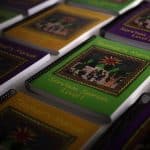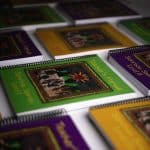
Teaching Spanish to beginners doesn’t have to feel overwhelming. Whether you’re starting a new school year or launching a new Spanish program, having clear, engaging Spanish lesson plans can make all the difference. This guide offers 20 beginner-friendly lessons and activities—grounded in real classroom experience—to help you create joyful, effective learning from Day 1.
Looking for complete, classroom-ready lesson plans? Request a free sample of the Sonrisas Spanish Curriculum
These simple and easy lesson ideas help students build essential vocabulary and confidence. Each lesson idea is designed to be developmentally appropriate for K–8 classrooms and can be adapted for different grade levels.
Objective: Introduce Spanish letters and pronunciation.
Plan: Display the alphabet visually. Practice letter sounds aloud with call-and-response. Have students pronounce the Spanish letter that their name begins with. Have students partner up and spell their names to each other using Spanish pronunciation. Highlight letters that differ from English (e.g., “ll,” “ñ,” “rr”). Use a chant or song to reinforce.
👉 Teaching Tip: Use visual aids like the Sonrisas Spanish Alphabet Posters which are part of the Sonrisas Calendar Time Curriculum to build letter recognition.
Objective: Teach numbers 0–10 through repetition and pattern recognition.
Plan: Start with 0–10 using manipulatives. Have students recite the date and count up to the number of the day. Play a guessing game based on the idea of, “I’m thinking of a number between 1 and 10.”
👉 The Sonrisas CD includes songs and chants focused on numbers.
Objective: Build interpersonal language skills with greetings and exchange of personal information.
Plan: Teach common phrases like Hola, Buenos días, ¿Cómo estás?, Adiós, and ¿Cómo te llamas tú?”. Model dialogues and encourage role play in pairs or groups.
Play the Me llamo game: Use a ball or hacky sack. Tell students that you are going to throw the ball to them and then ask them their name by saying, “¿Cómo te llamas tú?“. Tell them that they can tell you their name by saying, “Me llamo ___.” Then sing the Me llamo song from the Sonrisas CD.
📚 Curriculum Connection: Greetings, farewells, and games like the Me llamo game are integrated into the Circle Time segment of the Sonrisas Level I lessons.
Objective: Teach calendar themes and vocabulary.
Plan: Use songs to teach days of the week, months, seasons and weather. Establish a calendar routine within your daily lesson. Most young students are used to doing a calendar time routine, so doing this in Spanish class connects them to familiar content. The Sonrisas Calendar Time Curriculum is full of activities focused on calendar themes as well as geography activities focused on Spanish-speaking countries.
Objective: Understand gendered articles (el, la, un, una).
Plan: Start with color-coded examples, then practice with visuals and games. Reinforce with sentence building, sorting activities, and role-play.

Once foundational concepts are introduced, keep students engaged with hands-on, multimodal activities that support long-term acquisition and a immersive classroom environment.
Transform your bulletin board into a motivational display with student artwork, Spanish quotes, or cultural images. These can be especially meaningful if you have students with Hispanic heritage, and they include family photos or cultural products.
Use circles, pairs, or stations to increase collaboration and classroom energy. Better yet, do an actual Circle Time on the floor with students arranged in a circle.
Ask students to collect real-world Spanish examples (labels, ads, signs). Create a collage to link classroom content with daily life.
Have students trace their hands and write vocabulary words or reasons they enjoy Spanish on the hands. Display them as a community-building visual.
Introduce vocabulary words, then have students illustrate images that match the vocabulary. These are great for centers, peer practice, or assessment games.
Assign simple skits or dialogues in Spanish. Students will love creating videos of these. Videos foster creativity and speaking confidence. Learners do high level thinking and integration when they act out Spanish-based scenes and dialogues.
Support comprehension by having students illustrate posters, diagrams, or maps. Let students demonstrate comprehension as they create these graphic displays.
Promote memory retention and comprehension by having students label objects and furniture in the classroom. Add another level by color-coding the labels base on singular/plural or masculine/feminine
Assign colors to nouns, verbs, articles, etc. Use these in sentence-building and role-play activities.
Create posters, stories, or vocabulary walls using magazine cutouts. This reinforces visual learning, comprehension, and creativity.
Use Spanish-language music or create simple classroom chants. Music supports memory, engagement, and comprehension. We know from language acquisition research that young learners are especially adept at making language connections through music.
🎵 Try it: Our Preschool Curriculum incorporates music into every lesson.
Read short scripts or picture books to students. Alternate between choral reading, echo reading, and partner conversation. Story Time is an integral part of every Sonrisas Spanish lesson. Reading Spanish stories to children is a very effective way to provide comprehensible input and interpersonal communication in Spanish.
Capture audio or video of key lessons. Great for student review and asynchronous learning support.
Use TPR strategies or games like charades to reinforce meaning through movement.
Try “Spanish Simon Says,” Twister with vocabulary, or a classroom scavenger hunt. Learning through play is developmentally appropriate for young learners.
Focus on greetings, exchange of personal information, classroom language, and names. Build routines and structure, set expectations, and use visuals and music to introduce the language in a play-based mode. The Sonrisas Spanish Curriculum provides a consistent lesson structure for beginner Spanish lessons.
Use visuals, songs, repetition, and movement. Keep lessons simple, contextual, and short. Use lots of comprehensible input and provide opportunity for communication in the target language. Avoid explicit instruction in grammar.
A strong plan includes a clear goal or performance target, multi-modal interaction, multi-sensory input, and space for repetition and review. Bonus points for integrating culture and joy.
You can request a free sample of the Sonrisas Spanish Curriculum here. Designed for preschool and elementary classrooms, it builds real proficiency through music, role-play, storytelling, art, and student portfolio activities.
When you’re equipped with clear, developmentally appropriate Spanish lesson plans, your classroom becomes a space of discovery and connection. These ideas help you set the tone for a year of confident language use and meaningful cultural learning.
👉 Want ready-to-use, research-based Spanish lessons?
Request a free sample of the Sonrisas Spanish Curriculum and explore how we support teachers with everything they need to succeed.


